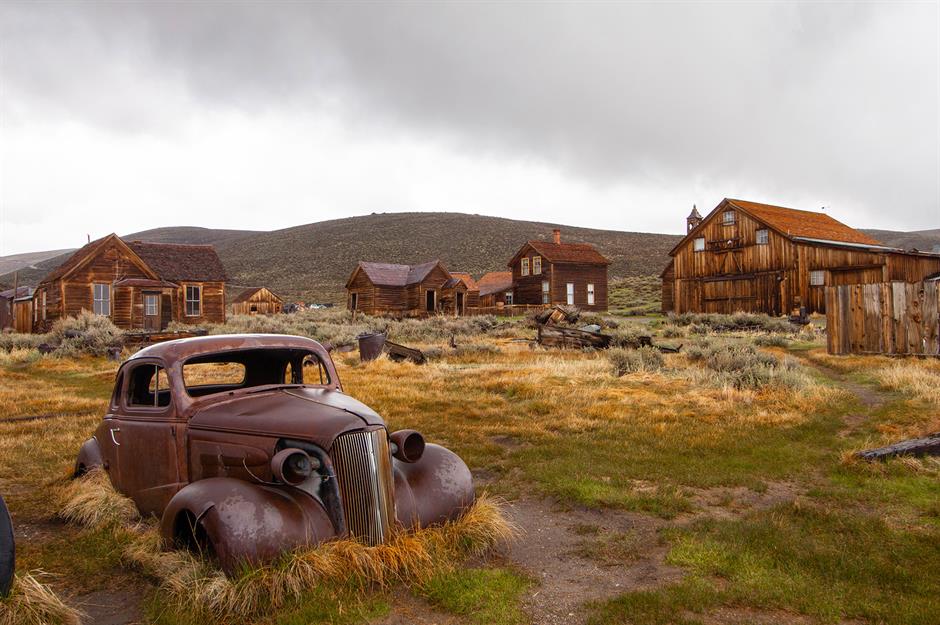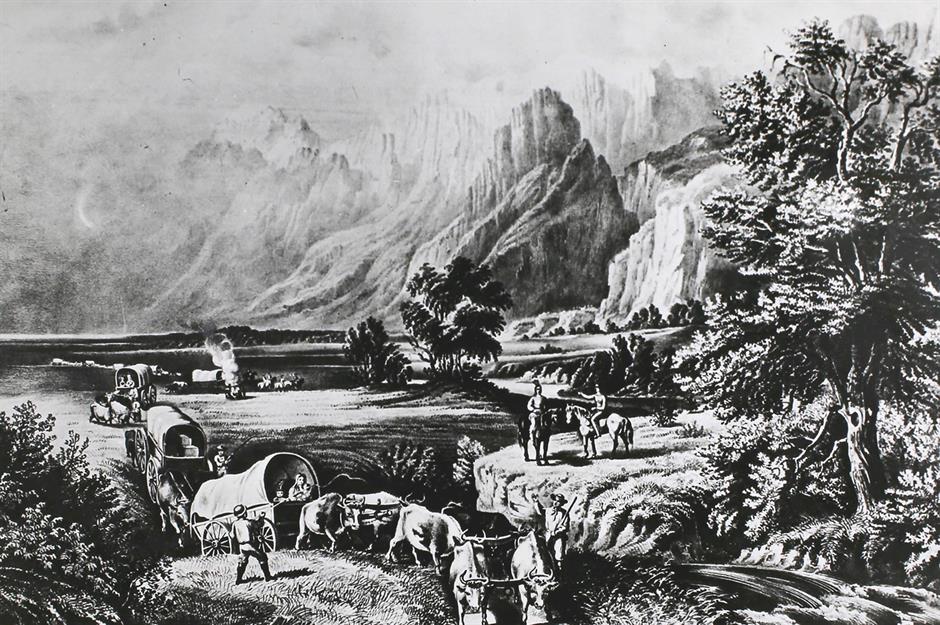The mysterious story of Bodie, America's eeriest ghost town
A tale of boom and bust
The USA is littered with ghost towns – but none of its abandoned settlements are as famous as Bodie, in California's Eastern Sierra region. More than a hundred cracked and crumbling buildings punctuate the High Desert landscape, reminders of a long-gone era when this was a thriving mining town of some 10,000 people. Read on to discover the mysterious story of Bodie – America's most notorious abandoned town.
It all started with rivers of gold
America’s gold rush is the stuff of dusty legend. Through the 1800s rich veins of gold were discovered about the creeks and rivers of the mighty American West, and thousands of prospectors flocked to the region hoping to make their fortune. Mines mushroomed across the modern-day western US and Canada, and buzzing and often lawless towns known for their saloons and bordellos grew up around them. Bodie’s story follows a similar trajectory.
Prospectors strike gold by Mono Lake
By the 1850s mines were springing up across California, and gold was first discovered in the state’s Mono Lake region (pictured) in 1852. It would be another seven years before the precious metal was discovered at the eventual site of Bodie, a little way north of the lake. The lode was hit upon by William S Bodey and three other men, and they were quick to stake their claim and set up camp.
The town’s namesake never saw its success
Sadly for William S Bodey, tragedy struck before he could collect his fortune. Conditions in California’s High Desert can be harsh and unpredictable, and Bodey was dead within a year after being caught in a winter snowstorm on a trip to pick up supplies. The fledgling town was named in his memory – some records say the changed spelling was due to a mispainted sign, others that it was deliberately altered to avoid people mispronouncing the town’s name.
Bodie gets off to a slow start
For a while Bodie was a small operation, and a relatively quiet town with just a handful of buildings. Gold reserves were moderate, especially when compared with bumper finds like the Comstock Lode (which saw rich silver deposits unearthed further north in Nevada). But that changed in the mid-1870s when fresh streams of gold were uncovered and the mining effort expanded dramatically.
Love this? Follow us on Facebook for travel inspiration and more
Bodie becomes a boomtown
Most of America’s gold rush stories involve boom and bust, and Bodie’s boom was much more dramatic than most. The town went from fewer than 20 buildings in 1875 to some 10,000 settlers and more than 250 buildings by 1879. Workers streamed into the town at an eye-watering rate, and the Main Street thrummed with activity.
A community is born
By the 1880s, Bodie had everything you’d expect from a thriving community – a bank (the remains of which are pictured), a school, hotels, newspapers, volunteer fire companies, cemeteries and a jail. Main Street wriggled out for more than a mile. Miners filled humble wooden houses, while the finer homes of the mine managers and owners spread out to the west. Of course, looming large on the eastern edge of town were the hulking mills and mine buildings, hives of activity that kept the town alive.
Bodie was a lawless place
Like many of America’s gold rush towns, Bodie was known as a dangerous and lawless place that helped breathe life into the idea of the 'Wild West'. There were purportedly dozens of watering holes, brothels, gambling dens and even opium dens, and gunfights of the sort you might see in a John Wayne movie were apparently not uncommon. The town even spawned a popular expression – 'a bad man from Bodie', meaning someone unusually violent or unpleasant. Pictured here is the now-decrepit jail.
There was a thriving Chinatown
Bodie’s mines drew workers from all over the world, including a large number of settlers from China. That meant that a busy Chinatown grew up in the suburbs, thought to have been home to hundreds of people. The district included laundries (many Chinese immigrants worked as launderers, partly due to discrimination in the mines), a Chinese restaurant and a Taoist temple, and reportedly hosted large Chinese New Year celebrations.
The bust comes as quickly as the boom
1879 was Bodie’s bumper year, but as early as 1880 the settlement began to decline. The town's reserves were becoming depleted and since new mining operations were kickstarting all the time, many residents set their sights on new horizons. It’s thought that by the mid-1880s, just 1,500 of the once-10,000 settlers remained. A fire in the summer of 1892 ripped through the dwindling downtown and it was rebuilt at a fraction of its original size. Pictured here is an abandoned home.
Churches are built in Bodie
Though Bodie’s future looked uncertain at the start of the 1880s, that didn’t stop a pair of churches from springing up – one Methodist, one Roman Catholic. Until then, there had been no purpose-built religious buildings in lawless Bodie, though there is known to have been a pair of preachers: the Methodist Reverend Hinkle and the Catholic Father Cassin.
Bodie is rocked by vigilante violence
Damning and debaucherous tales were plentiful in Bodie during the 1870s and 1880s – but perhaps the most notorious is the tale of the so-called '601 vigilante group'. In 1881, or so the story goes, a man named Joseph DeRoche danced with Thomas Treloar’s wife against his will. The exact events are hazy, but it’s said that DeRoche left early and waited in ambush for the Treloars to depart too, shooting Thomas Treloar in the head. The men of the so-called 601 vigilante group then captured DeRoche and hanged him for his crime – '601' is thought to mean 'six feet under, zero trials, one rope'. Pictured in these photographs are some of the town's early residents.
Bodie endures difficult decades
For decades following the 1892 fire Bodie continued as a mining town, but its heyday was long buried in the dust. Just a fragment of the town’s settlers remained and the mining operation shrank dramatically. Another devastating fire – apparently started by a child playing with matches – ravaged the settlement in 1932, choking part of Main Street and shrinking Bodie once again. The Great Depression took its toll too.
The last mine closed during the Second World War
The death knell sounded for Bodie during the Second World War, when mining ceased altogether. The very last mine was the ironically named Lucky Boy, which shuttered in 1942. By this point, only a handful of residents remained in Bodie, and they too soon quit the town, leaving it in a state of total abandonment. The discarded Roseclip gold mine moulders in this photograph.
Bodie faces an uncertain future
Left to the whims of Mother Nature, Bodie’s historic buildings risked being lost forever. They stood in the grip of the bracing High Desert climate, decaying and forgotten. However, the site’s remote location meant it was mostly spared from vandals, stuck in time and preserved almost exactly as its last residents had left it.
The Methodist church is vandalised
Sadly, though, not all Bodie’s buildings were spared from criminal damage during the town’s time in limbo. The Methodist church was vandalised sometime during this period, and though its impressive shell remains intact, a precious oil cloth bearing the ten commandments was stolen and lost forever.
Discover the most beautiful small towns and cities in California
The ghost town becomes a state park
In the 1960s, the haunting ghost town – which had by then been left to rot for two decades – was finally afforded some extra protections. First, in 1961, it became a National Historic Landmark District, and then, in 1962, it was awarded state park status. A proud park ranger is pictured here after the designation.
Bodie is in a state of 'arrested decay'
The decision was made not to repair the buildings, but instead leave them exactly as they were when the final residents trickled out in the 1940s – in a state of "arrested decay". It's a delicate balance of preservation: maintaining the ruins as they are without restoring them. Now 110 buildings remain on the site, still filled with some of the furniture and personal items that their former inhabitants left behind. The rusted remains of old cars squat between the buildings too.
The bones of the town are still recognisable
Wandering around the town’s deserted streets, it’s easy to spot key buildings that were once vital to Bodie’s community. There’s the creaking Methodist church, with its neat portico and wooden steeple; the decrepit saw mill; the compact jail; the stumpy brick remains of the old bank building; and the firehouse (pictured), with its striking belfry.
You can still see houses that belonged to Bodie’s most important residents
As you meander the ghost town’s tangle of ramshackle buildings you’ll see structures that once belonged to Bodie’s dignitaries. Peek into the Metzger House (pictured), the one-time home of Henry Metzger, who was foreman of the Standard Mill until it closed in 1916. One of the site's finest homes was possessed by James Stuart Cain, a key property owner who became one of Bodie's most affluent residents.
You can take a walk around Bodie’s cemetery
Wandering Bodie’s cemetery is an eerie experience. It’s thought that some 200 people are interred in the burial ground and there are at least 150 grave markers. Amble between the stones, looking out for engravings that haven’t been weathered away by Bodie’s abrasive winters.
Bodie becomes an unlikely tourist hit
Today Bodie is an offbeat but ever-popular tourist attraction in the Eastern Sierra, pulling in more than 200,000 visitors a year. In order to retain the town's Old West feel, tourist services are extremely limited – just restrooms, a small museum and a picnic area by the parking lot. The joy is in wandering between the abandoned structures, peering through dusty windows, photographing creaking relics and imagining what life here once looked like.
The town is enchanting in winter
Come winter, Bodie is wrapped in a blanket of thick snow and the town’s old buildings sit in a magical hush. The only way in and out of the town during this time is on cross-country skis, snowmobiles or snowshoes, so it’s a real seasonal adventure that requires forward planning. Check ahead as the park may be closed during particularly extreme weather.
Things sometimes go bump in the night
Unsurprisingly, ghost stories connected with Bodie are rife and the Bodie Foundation runs ghost walks to tell the town’s haunting tales. According to legend, the JS Cain house (pictured) is the most haunted of all. It’s purportedly the home of a spirit maid who is kind to kids but loathes adults, pushing and shoving them, and also opens and shuts doors with a bang.
Legend has it there’s a Bodie curse
It’s forbidden to take anything with you when you leave Bodie, be it a preserved artefact or just a dusty rock. However, not all visitors have followed Bodie’s 'leave no trace' policy – and they’ve apparently paid the price. It’s said that those who steal from Bodie are inflicted with the Bodie curse, and letters to the park (often with returned objects enclosed) apparently detail all kinds of misfortunes as a result, from the appearance of spirits to simple bouts of bad luck.
Now discover more of the eeriest abandoned ghost towns in the US

